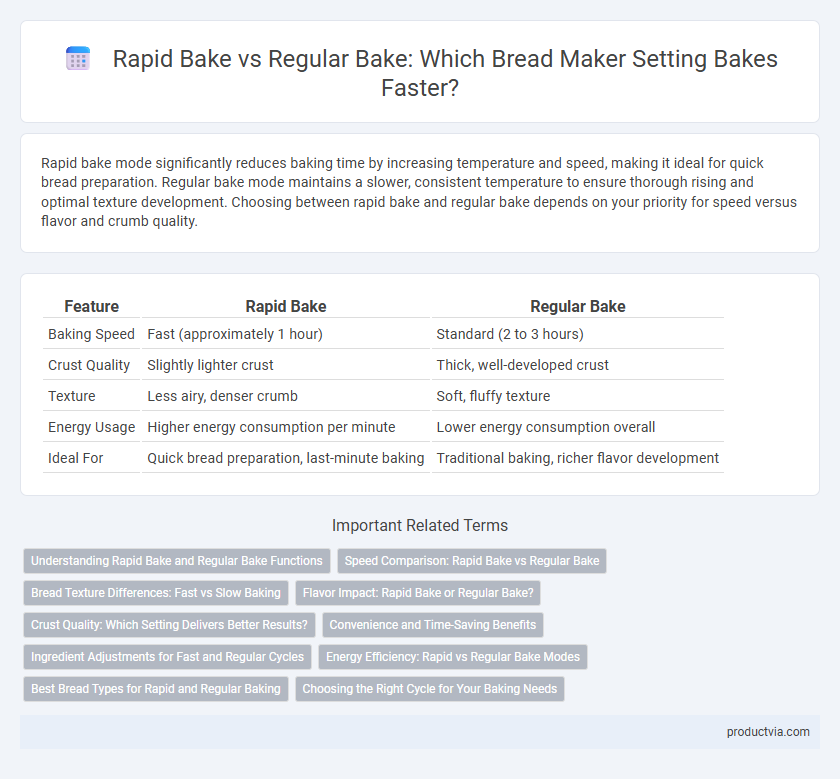Rapid bake mode significantly reduces baking time by increasing temperature and speed, making it ideal for quick bread preparation. Regular bake mode maintains a slower, consistent temperature to ensure thorough rising and optimal texture development. Choosing between rapid bake and regular bake depends on your priority for speed versus flavor and crumb quality.
Table of Comparison
| Feature | Rapid Bake | Regular Bake |
|---|---|---|
| Baking Speed | Fast (approximately 1 hour) | Standard (2 to 3 hours) |
| Crust Quality | Slightly lighter crust | Thick, well-developed crust |
| Texture | Less airy, denser crumb | Soft, fluffy texture |
| Energy Usage | Higher energy consumption per minute | Lower energy consumption overall |
| Ideal For | Quick bread preparation, last-minute baking | Traditional baking, richer flavor development |
Understanding Rapid Bake and Regular Bake Functions
Rapid bake function accelerates the bread-making process by using higher temperatures and faster kneading cycles to produce bread in less than an hour. Regular bake mode follows a traditional timeline with slower rising and baking phases, ensuring enhanced flavor development and a denser crumb texture. Understanding these functions helps users balance between convenience with rapid bake and quality with regular bake settings for optimal homemade bread results.
Speed Comparison: Rapid Bake vs Regular Bake
Rapid bake mode drastically reduces baking time by accelerating the kneading and rising processes, completing a loaf in around 60 minutes compared to the 3 to 4 hours required by the regular bake setting. This speed is achieved through higher temperatures and enhanced yeast activation, while regular bake provides a gentler, slower rise for improved flavor development and crumb texture. Choosing rapid bake is ideal for quick bread preparation, whereas regular bake is preferred for traditional, artisanal-quality loaves.
Bread Texture Differences: Fast vs Slow Baking
Rapid bake cycles in bread makers significantly reduce baking time by increasing temperature and speed, resulting in a denser and less airy bread texture. Regular bake cycles use slower fermentation and longer baking times, promoting better gluten development and producing a fluffier, more evenly textured loaf. Choosing fast baking sacrifices crumb softness and rise quality for convenience, while slow baking enhances the bread's elasticity and flavor depth.
Flavor Impact: Rapid Bake or Regular Bake?
Regular bake mode enhances flavor development by allowing longer fermentation and gradual browning, resulting in richer taste and better crumb texture in bread. Rapid bake mode significantly reduces baking time but may sacrifice some depth of flavor due to shortened fermentation and quicker crust formation. For optimal flavor, regular bake is preferred despite the longer baking time.
Crust Quality: Which Setting Delivers Better Results?
Rapid bake setting in bread makers significantly reduces baking time by increasing temperature and fan speed, which often results in a crust that is thinner and less evenly browned compared to the regular bake setting. Regular bake cycles, with slower and steadier heat application, promote a thicker, more uniform crust with a richer color and enhanced texture. For users prioritizing crust quality, the regular bake setting delivers superior results by allowing the Maillard reaction to develop fully, enhancing both flavor and visual appeal.
Convenience and Time-Saving Benefits
Rapid bake cycles in bread makers significantly reduce baking time, completing a loaf in as little as one hour compared to the three to four hours needed for regular bake settings. This accelerated process enhances convenience for busy individuals by delivering fresh bread quickly without sacrificing quality. Time-saving benefits make rapid bake ideal for last-minute meal preparations or spontaneous baking desires.
Ingredient Adjustments for Fast and Regular Cycles
Rapid bake cycles in bread makers require precise ingredient adjustments, such as reducing yeast and liquid quantities to prevent overproofing and dense texture. Regular bake cycles allow a more balanced ingredient ratio, supporting gradual fermentation for enhanced flavor and crumb structure. Optimizing ingredient measurements based on the baking speed improves bread quality and consistency.
Energy Efficiency: Rapid vs Regular Bake Modes
Rapid bake mode in bread makers significantly reduces baking time by increasing temperature and fan speed, resulting in higher energy consumption compared to regular bake mode. Regular bake mode uses a slower, steady heat process that optimizes energy use by maintaining consistent temperatures, making it more energy-efficient over longer baking durations. Choosing regular bake mode balances energy savings with bread quality, while rapid bake mode prioritizes speed at the cost of increased energy usage.
Best Bread Types for Rapid and Regular Baking
Rapid bake cycles in bread makers are ideal for softer breads like sandwich loaves and white bread, offering a faster rise and bake time without compromising texture. Regular bake settings suit denser and more complex breads such as whole grain, rye, or artisan varieties, allowing longer fermentation for enhanced flavor and crumb structure. Understanding these preferences ensures optimal results for different bread types, balancing speed and quality.
Choosing the Right Cycle for Your Baking Needs
Rapid bake cycles significantly reduce baking time, typically completing a loaf in under an hour, making them ideal for busy schedules or last-minute baking. Regular bake cycles, though slower, usually take about 3 to 4 hours and provide a more thorough rise and uniform texture, which is preferable for complex doughs. Choosing the right cycle depends on balancing the need for speed with desired bread quality and texture.
Rapid bake vs Regular bake for baking speed Infographic

 productvia.com
productvia.com